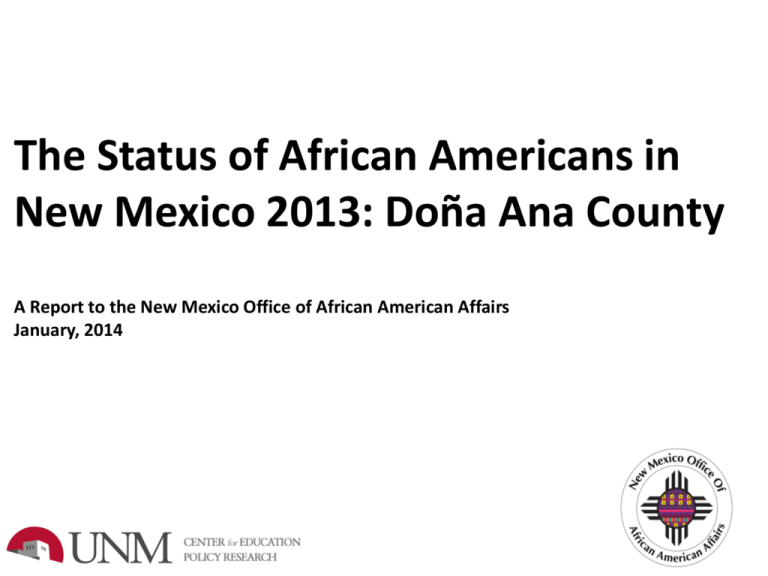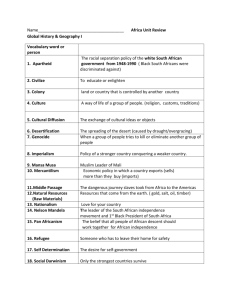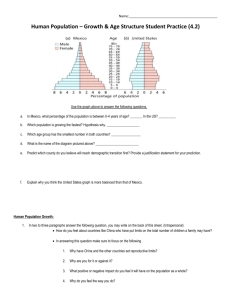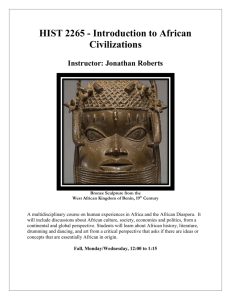Mapping the Landscape of Educational Outcomes in Albuquerque
advertisement

The Status of African Americans in New Mexico 2013: Doña Ana County A Report to the New Mexico Office of African American Affairs January, 2014 Table of Contents • Introduction, Data Availability • Demographics of Dona Ana County • Education – – – – – • Economics – – – – • Unemployment Rates Median Household Income Population below the federal poverty line Owner to Renter Ratio Risk and Resiliency Factors – 2 Math and Reading Proficiencies High School Graduation Rates Postsecondary Education Graduation from Postsecondary Education Types of degrees awarded High School • Health Issues – – – – – – – – – – – – Overview Children without health insurance coverage Adult binge drinkers Adult current smokers Adults no physical activity Diabetes High blood pressure High cholesterol Adolescent Births Percentage of births with no prenatal care Heart deaths HIV deaths Introduction • This report represents a follow-up to a 2012 presentation on the status of African Americans across New Mexico. • The data in the original report has been updated where possible (see Table 1). • This report focuses primarily on Doña Ana County, New Mexico, and where possible, county-specific data has been used. However, due to small population numbers, much of the data in this report is for the entire state and not just Doña Ana County. • One of our most important findings is that important data on the status of African Americans in New Mexico ranges from easily accessible to non-existent. • One of our most important recommendations is that the NM OAAA develop and keep a current and comprehensive database that can be used effectively in advocacy and policy related to African Americans in New Mexico. 3 Data Availability: Table 1 Source Indicator Aggregation Unit Current Version Previous Version 2011 2009 1. YRRS Risk and Resiliency Data, High School State - Level; Disaggregated NM Statistically significant differences between African American and Caucasian students. Previous version presented aggregated data at the county level. We now present disaggregated data at the state level. 2. New Mexico Department of Health, IBIS; Centers for Disease Control; Behavioral Risk Factor Surveillance System (BRFSS) Binge Drinking BMI 25+ Current Smoker Diabetes No Physical Activity High BP High Cholesterol NM 2011 2006-10 US NM US NM US NM US NM US NM NM 2011 2011 2011 2011 2011 2011 2011 2011 2011 2011 2011 2006-10 2006-10 2006-10 2006-10 2006-10 2006-10 2006-10 2006-10 2006-10 2006-10 2006-10 BRFSS changed their survey methodologies in the 2011 survey. As a result, data from 2010 and before are not comparable to 2011 data. Because we only have one year of data, counts/estimates are too small to provide statistically reliable data at the county level as was done in the previous report. 4 Data Availability: Table 1 Source Indicator Aggregation Unit Current Version Previous Version NM 2007-11 2006-10 3. New Mexico Department of Health, IBIS - Vital Statistics Births to 15-17 Year Olds per 100K Heart_Deaths_Per_1000 HIV_DeathsPer_100K No_PreN_Perc NM 2011 2006-10 NM 2007-11 2006-10 NM 2007-11 2006-10 These numbers have been updated to the most recent five year window of available data. The two windows are not comparable. Where possible, rates for only 2011 are included to present the most recent estimates. Data are generally too sparse to be able to look at county-level data in a statistically meaningful way. 4. District Data From New Mexico Public Education Department Graduation Rates 3/8/11 Math/Reading SBA Exam District District 2012 2013 2011 2011 Population 2007-11 2010 Median Income Unemployment Below FPL Own : Rent No Health Insurance: Total No Health Insurance: Children 2007-11 2007-11 2007-11 2007-11 2009-11 2009-11 2005-10 2005-10 2005-10 2005-10 5. Census Data: County and Tract # in homeless shelters* # in correctional facilities* # in juvenile facilities* 5 Only County Only County 2010 2010 2010 *Groups quarters data are only available from the decennial census. As a result, these data have not been updated. Data Availability: Table 1 Source Indicator Aggregation unit Current Version Previous Version 6. National Center for Education Statistics Integrated Post Secondary Education Data System (IPEDS) 7. Office of Civil Rights Reporting Enrollment NM 2011-12 Completion NM 2011-12 2009-10 ACT/SAT/AP Data 2009-10 Students enrolled in Gifted programs 2009-10 New data have not been made available since first report. 6 Why Does Data Matter in Policy and Advocacy? • Data provides us with insight into the education, health, and economic issues facing New Mexico’s children, families and communities. • Data provides us with a basis for advocacy and enable partnerships to come to consensus on pragmatic ways to address critical challenges including disparities in racial, cultural, economic, and political equality. • Data enables us to ask better questions about the challenges we face; the laws, regulations, budgets, programs and policies we pass; and the barriers that keeps us from working collaboratively. • Data helps us prioritize limited resources by identifying where our citizens are most in need, how our sources of support are deployed, and where the gaps remain. • Data helps us hold each other accountable by tracking the outcomes that matter and by providing fair and independent information that people of good will can use to strengthen their efforts. 7 DOÑA ANA COUNTY Demographics 8 African Americans in Doña Ana County, New Mexico General Demographics: Percent of County Population: 2.1% Number of Persons: 4,503 Median Income: $32,168 Unemployment: 12% Below poverty line: 18.2% Ratio of Home Owners to Renters: .79 Largest Population: Las Cruces, New Mexico 9 Population data from U.S. Census Dona Ana County Quick Facts. Other data from 2007-2011 ACS 5-year estimate. African Americans in New Mexico Counties (2010 Census) Less than 1.8% 1.8 - 5.0% 5.1 - 10.0% Greater than 10% 10 Source: U.S. Census Bureau, 2010 Census. African Americans in Doña Ana County Communities by Census Block Group 0% - 3.7% 3.7% - 14.1% 14.1% - 25.7% 11 Source: 2007-2011 American Community Survey 5-Year Estimates. B01001: Sex By Age. African Americans in Las Cruces by Census Block Group 0% - 3.7% 3.7% - 14.1% 14.1% - 25.7% 12 Source: 2007-2011 American Community Survey 5-Year Estimates. B01001: Sex By Age. K-12 Enrollment by Ethnicity, Doña Ana County Public Schools, 2010-2011 School Year 2% LAS CRUCES PUBLIC SCHOOLS Native American Asian Hispanic HATCH VALLEY PUBLIC SCHOOLS African American White GADSDEN INDEPENDENT SCHOOLS 0% 13 10% 20% 30% 40% 50% 60% 70% 80% 90% 100% Source: U.S. Department of Education, National Center for Education Statistics, Common Core of Data (CCD), "Local Education Agency (School District) Universe Survey", 2010-11 v.2a. DOÑA ANA COUNTY Education: Standards Based Assessment 14 A Note on the Standards Based Assessment (SBA) Data • Because of small numbers, data on the SBA examination for African Americans is only available for 9 New Mexico school districts. • Data is reported for Las Cruces Public Schools in Doña Ana County, which is shown in the next slides, in comparison with other New Mexico districts and the state overall. • There are a total of 626 African American students enrolled in Las Cruces Public Schools. 15 SBA Proficiencies by Grade and Ethnicity, 2013 Las Cruces Public School District and the State of New Mexico Math 8th Grade Math 3rd Grade Math 11th Grade Math 80.0% 80.0% 80.0% 60.0% 60.0% 60.0% 40.0% 40.0% Las Cruces 40.0% Las Cruces 20.0% Statewide 20.0% 0.0% Statewide Las Cruces 20.0% Statewide 0.0% 0.0% African Caucasian Hispanic American African Caucasian Hispanic American African Caucasian Hispanic American Reading 3rd Grade Reading 80.0% 100.0% 80.0% 60.0% Las Cruces 40.0% Statewide 20.0% 0.0% 60.0% 40.0% 20.0% 0.0% African Caucasian Hispanic American 16 8th Grade Reading 11th Grade Reading 80.0% 60.0% Las Cruces Statewide 40.0% Las Cruces 20.0% Statewide 0.0% African Caucasian Hispanic American African Caucasian Hispanic American Source: NM PED. Standards Based Assessment (SBA). 2013. Note: “Caucasian – African-American Gap” derived as Caucasian percentage minus the African-American Percentage. Percentage of 3rd Grade Students Proficient and Above in Math, By Race and School District 0% 20% 40% 60% 80% 100% Alamogordo African American/Caucasian Disparity Albuquerque African American Caucasian GAP Carlsbad Las Cruces 30.4% 67.2% 36.8% Statewide 47.7% 66.0% 18.2% Alamogordo 51.3% 64.7% 13.4% Albuquerque 43.3% 71.0% 27.7% Carlsbad 54.5% 66.0% 11.5% Clovis 57.4% 70.7% 13.3% Farmington 40.0% 59.5% 19.5% Hobbs 45.7% 71.8% 26.1% Rio Rancho 60.4% 68.2% 7.8% Roswell 76.5% 68.2% -8.3% Clovis Farmington Hobbs Las Cruces Rio Rancho Roswell Statewide African American 17 Caucasian American Indian Hispanic Source: NM PED. Standards Based Assessment (SBA). 2013. Note: “Caucasian – African-American Gap” derived as Caucasian percentage minus the African-American Percentage. Percentage of 3rd Grade Students Proficient and Above in Reading, By Race and School District 0% 20% 40% 60% 80% 100% Alamogordo African American/Caucasian Disparity Albuquerque African American Caucasian GAP Carlsbad Las Cruces 52.2% 72.5% 20.3% Statewide 56.6% 71.1% 14.4% Farmington Alamogordo 43.6% 61.7% 18.1% Hobbs Albuquerque 52.1% 75.4% 23.3% Carlsbad 63.6% 72.7% 9.1% Clovis 59.6% 73.8% 14.2% Farmington 60.0% 69.9% 9.9% Hobbs 60.0% 66.8% 6.8% Rio Rancho 77.4% 76.5% -0.9% Roswell 52.9% 66.7% 13.8% Clovis Las Cruces Rio Rancho Roswell Statewide African American 18 Caucasian American Indian Hispanic Source: NM PED. Standards Based Assessment (SBA). 2013. Note: “Caucasian – African-American Gap” derived as Caucasian percentage minus the African-American Percentage. Percentage of 8th Grade Students Proficient and Above in Math, By Race and School District 0% 20% 40% 60% 80% 100% African American/Caucasian Disparity Alamogordo African American Caucasian Albuquerque Carlsbad Las Cruces Clovis Farmington GAP 45.2% 57.0% 11.8% Statewide 33.3% 58.6% 25.3% Alamogordo 31.4% 65.5% 34.1% Albuquerque 30.1% 62.5% 32.4% Carlsbad 30.0% 48.1% 18.1% Clovis 46.9% 65.9% 19.0% Farmington 18.2% 44.4% 26.2% Hobbs 25.7% 55.6% 29.9% Los Lunas 28.6% 51.3% 22.7% Rio Rancho 37.0% 66.6% 29.6% Roswell 36.4% 68.6% 32.2% Hobbs Las Cruces Los Lunas Rio Rancho Roswell Statewide African American 19 Caucasian American Indian Hispanic Source: NM PED. Standards Based Assessment (SBA). 2013. Note: “Caucasian – African-American Gap” derived as Caucasian percentage minus the African-American Percentage. Percentage of 8th Grade Students Proficient and Above in Reading, By Race and School District 0% 20% 40% 60% 80% 100% African American/Caucasian Disparity Alamogordo African American Caucasian Albuquerque Las Cruces Carlsbad Clovis GAP 61.9% 78.0% 16.1% Statewide 53.9% 75.4% 21.5% Alamogordo 51.4% 80.4% 29.0% Albuquerque 57.1% 79.2% 22.1% Carlsbad 54.5% 71.6% 17.1% Clovis 63.3% 80.3% 17.0% Farmington 45.5% 71.1% 25.6% Hobbs 34.3% 64.4% 30.1% Los Lunas 35.7% 71.7% 36.0% Rio Rancho 53.7% 76.3% 22.6% Roswell 45.5% 79.4% 33.9% Farmington Hobbs Las Cruces Los Lunas Rio Rancho Roswell Statewide African American 20 Caucasian American Indian Hispanic Source: NM PED. Standards Based Assessment (SBA). 2013. Note: “Caucasian – African-American Gap” derived as Caucasian percentage minus the African-American Percentage. Percentage of 11th Grade Students Proficient and Above in Math, By Race and School District 0% 20% 40% 60% 80% 100% African American/Caucasian Disparity Alamogordo African American Caucasian Albuquerque Las Cruces GAP 38.6% 63.5% 24.9% Clovis Statewide 30.4% 59.3% 28.9% Hobbs Alamogordo 21.2% 59.3% 38.1% Albuquerque 30.1% 63.4% 33.3% Clovis 25.0% 54.3% 29.3% Hobbs 26.9% 50.3% 23.4% Los Lunas 41.7% 39.2% -2.5% Rio Rancho 44.2% 70.3% 26.1% Roswell 18.2% 61.3% 43.1% Las Cruces Los Lunas Rio Rancho Roswell Statewide African American 21 Caucasian American Indian Hispanic Source: NM PED. Standards Based Assessment (SBA). 2013. Note: “Caucasian – African-American Gap” derived as Caucasian percentage minus the African-American Percentage. Percentage of 11th Grade Students Proficient and Above in Reading, By Race and School District 0% 20% 40% 60% 80% 100% African American/Caucasian Disparity Alamogordo Row Labels African American Caucasian GAP Las Cruces 55.6% 72.0% 16.4% Statewide 52.1% 71.1% 19.0% Hobbs Alamogordo 48.5% 74.4% 25.9% Las Cruces Albuquerque 51.9% 74.5% 22.6% Clovis 40.0% 64.1% 24.1% Hobbs 40.7% 58.9% 18.2% Los Lunas 50.0% 56.8% 6.8% Rio Rancho 67.3% 81.8% 14.5% Roswell 63.6% 66.1% 2.5% Albuquerque Clovis Los Lunas Rio Rancho Roswell Statewide African American 22 Caucasian American Indian Hispanic Source: NM PED. Standards Based Assessment (SBA). 2013. Note: “Caucasian – African-American Gap” derived as Caucasian percentage minus the African-American Percentage. Change in SBA Scores, 2011-12 to 2012-13 School Years: Las Cruces Public Schools, African American Students 2011-2012 % Proficient 2012-2013 % Proficient Percentage Change Reading 51% 52.2% 2.3% Math 38.8% 30.4% -21.6% Reading 35.3% 61.9% 75.4% Math 41.2% 45.2% 9.7% Reading 40% 55.6% 39% Math 28.4% 38.6% 36% Assessment Area (number of students tested 2012, 2013) 3rd Grade 8th Grade 11th Grade 23 Source: NM PED. Standards Based Assessment (SBA), 2011-2012, 2012-2013. Note: Percentage change is the change between years as a percentage of the 2011-2012 proficiency rate. DOÑA ANA COUNTY Education: Graduation Rates 24 4-Year High School Graduation Rates, 2012 Cohort 0 20 40 60 80 African American/Caucasian Disparity African American Caucasian GAP Las Cruces 75.6% 82.5% 6.9% Statewide 69.3% 77.2% 7.9% Alamogordo 79.35% 82.4% 3.1% Albuquerque 62.7% 74.6% 11.9% Clovis 81.1% 86.8% 5.7% Farmington 81.3% 76% -5.3% Hobbs 78.4% 78.9% 0.5% 81% 83% 2% 56.2% 73.2% 17% 100 Alamogordo Albuquerque Clovis Farmington Hobbs Las Cruces Rio Rancho Rio Rancho Roswell Roswell In 2011, the graduation rate of African American students in Las Cruces was 71.6%. In 2012 It was 75.6%. Statewide African American 25 Caucasian American Indian Hispanic Source: NM PED. 2012. Note: “Caucasian – African-American Gap” derived as Caucasian percentage minus the African-American Percentage. Change in African American High School Graduation Rate: 2010-2011 to 2011-2012 90.0% 80.0% 81.1% 79.7% 79.3% 81.3% 81.0% 78.4% 76.2% 75.6% 74.7% 71.6% 71.5% 70.0% 62.7% 60.0% 60.7% 60.9% 56.2% 55.5% 50.0% 40.0% 30.0% 20.0% 10.0% 0.0% Alamogordo Albuquerque Clovis Farmington Hobbs Las Cruces Rio Rancho Roswell 2010-2011 2011-2012 26 Source: NM PED 2010-2011, 2011-2012. DOÑA ANA COUNTY Postsecondary Education 27 A Note on the Postsecondary Education Data • Data on post-secondary enrollment and graduation comes from the National Center for Education Statistics Integrated Postsecondary Education Data System (IPEDS). • This data is collected from institutions of higher education in New Mexico but includes all students, not just students from New Mexico. 28 Major Dona Ana County Institutions of Higher Education: New Mexico State University (NMSU) and Dona Ana Community College (DACC) Enrollment and Completion African American Enrollment at NMSU in 2012: 512 African American Students 2.9% of total enrollment Degrees Awarded to African Americans at NMSU in 2012: 2.3% of bachelor’s degrees (76 total) 1.8% of master’s degrees 2.9% of doctor’s degrees African American Enrollment at DACC in 2012: 216 African American Students 2.3% of total enrollment Degrees and Certificates Awarded to African Americans at DACC in 2012: 27 Degrees and Certificates 2.2% of all degrees and certificates 29 Source: IPEDS Data Center > Custom Data Files > Enrollments by race, ethnicity, gender 2012; Completions/number of students receiving awards/degrees by race/ethnicity and gender 7/1/20016/30/2012. Massage Therapy Training Institute did not report degree awards. Major Dona Ana County Institutions of Higher Education: New Mexico State University (NMSU) and Dona Ana Community College (DACC) African American Student Organizations and Facts NMSU African Unity Club NMSU Black Student Association NMSU Gospel Choir NMSU Chapter: National Society of Black Engineers NMSU Chapter: Phi Beta Sigma Fraternity NMSU Chapter: Zeta Phi Beta Sorority NMSU’s Black Programs won the Insight from Diversity Higher Education Excellence Award in 2012 NMSU’s Clara Belle Williams Hall is named for the first African American student to graduate from NMSU in 1937 30 Source: New Mexico State University website http://www.nmsu.edu/~blackpro/campus-life.html. Postsecondary Institutions: African American Enrollment > 5% of Institution Total Institution Doña Ana County 31 Number of African American Students Percent of Total Students Olympian University of Cosmetology 269 20.2% University of the Southwest 102 16.2% New Mexico Military Institute 59 13.4% Pima Medical Institute 2 7.0% New Mexico Highlands Univ. 215 6.1% DeWollff College Hair Styling 7 6.0% New Mexico Junior College 181 5.8% Massage Therapy Training Institute 2 5.7% National American University Albuquerque (2 locations) 51 5.8% Santa Fe University of Art and Design 25 5.7% Southwest Acupuncture College-Santa Fe 3 5.1% Source: IPEDS Data Center > Custom Data Files > Enrollment by race/ethnicity and gender, Fall 2011. Note: These numbers include all post-secondary degree granting institutions in New Mexico (n=53). Enrollments at All New Mexico Postsecondary Degree Granting Institutions Fall, 2011 45.0% 42.1% 40.0% 36.1% 35.0% 30.0% 25.0% 20.0% 15.0% 9.0% 10.0% 6.2% 5.0% 0.2% 1.6% 1.7% Asian Two or more Races 3.1% 0.0% Hawaiian Pacific 32 African American Unknown American Indian White Hispanic Source: IPEDS Data Center > Custom Data Files > Enrollment by race/ethnicity and gender, Fall 2011. Note: These numbers include all post-secondary degree granting institutions in New Mexico (n=53). Postsecondary Institutions: African American Enrollment > 5% of Institution Total 33 6-Year Graduation Rates from 2- and 4-Year New Mexico Public Postsecondary Institutions by Ethnic Group, 2010-2011 50.0% 45.0% 40.0% 35.0% 30.0% American Indian Asian 25.0% African American Hispanic 20.0% Caucasian 15.0% 10.0% 5.0% 0.0% 2-Year Instituitions 34 4-Year Institutions Source:IPEDS Data Center > Custom Data Files > Graduation Rates/Graduation rate data, 150% of normal time to complete - cohort year 2005 (4-year) and cohort year 2008 (2-year) institutions. Note: These numbers include all public post-secondary degree granting institutions in New Mexico. Number of Bachelor’s Degrees Awarded to African American students by New Mexico Institutions, by Major, SY 2011-12 Business, Management, Marketing, And Related Support Services, 37 Other, 46 Liberal Arts And Sciences, General Studies And Humanities, 25 Family And Consumer Sciences/Human Sciences, 7 Engineering, 8 Visual And Performing Arts, 8 Social Sciences, 24 Biological And Biomedical Sciences, 13 Homeland Security, Law Enforcement, Firefighting And Related Protective Education, 14 Services, 13 35 Health Professions And Related Programs, 17 Psychology, 17 Source: IPEDS Data Center > Custom Data Files > Completions/Awards/degrees conferred by program (CIP), award level, race/ethnicity, and gender: July 1, 2011 to June 30, 2012. Note: These numbers include all post-secondary degree granting institutions in New Mexico. Associate’s Degrees Awarded to African American students by New Mexico Institutions, by Major, SY 2011-12 Other 15% Computer And Information Sciences And Support Services 3% Mechanic And Repair Technologies/Technicians 3% Liberal Arts And Sciences, General Studies And Humanities 47% Engineering Technologies And Engineering-Related Fields 4% Homeland Security, Law Enforcement, Firefighting And Related Protective Services 4% Business, Management, Marketing, And Related Support Services 8% Health Professions And Related Programs 16% 36 Source: IPEDS Data Center > Custom Data Files > Completions/Awards/degrees conferred by program (CIP), award level, race/ethnicity, and gender: July 1, 2011 to June 30, 2012. Note: These numbers include all post-secondary degree granting institutions in New Mexico. Certificates/Awards granted to African American students by New Mexico Institutions, by Major, SY 2011-12 Engineering Technologies And Engineering-Related Fields 3% Construction Trades 2% Other 7% Computer And Information Sciences And Support Services 3% Transportation And Materials Moving 3% Personal And Culinary Services 47% Mechanic And Repair Technologies/Technicians 4% Business, Management, Marketing, And Related Support Services 9% Health Professions And Related Programs 22% 37 Source: IPEDS Data Center > Custom Data Files > Completions/Awards/degrees conferred by program (CIP), award level, race/ethnicity, and gender: July 1, 2011 to June 30, 2012. Note: These numbers include all post-secondary degree granting institutions in New Mexico. DOÑA ANA COUNTY Economics 38 African Americans in Doña Ana County, New Mexico Economic Data: Comparisons by Ethnic Groups and Geography African American Median Income Unemployment Below Federal Poverty Line Own To Rent Ratio 39 Caucasian Hispanic American Indian Asian United States New Mexico Doña Ana County $35,635 $39,386 $32,168 $57,597 $53,454 $50,712 $41,965 $36,942 $30,225 $37,511 $33,835 $32,799 $70,815 $55,591 $50,804 United States New Mexico Doña Ana County 15% 8.9% 12% 7.2% 6% 8.4% 10.6% 9.5% 11.6% 14.8% 13.3% 20.6% 6.9% 7.9% 12.9% United States New Mexico Doña Ana County 25.8% 22.5% 18.2% 9.9% 10.7% 12.5% 23.2% 24.1% 32% 27% 31.4% 27.6% 11.7% 12.7% 14.5% United States New Mexico Doña Ana County 0.83 0.84 0.79 2.73 2.71 2.34 0.93 2.09 1.81 1.20 1.74 1.27 1.42 1.76 .88 Source: 2007-2011 American Community Survey 5-Year Estimates. Unemployment Rate, By Race 25 20 15 United States New Mexico Doña Ana County 10 5 0 African American Geography United States New Mexico Doña Ana County 40 Caucasian Total 8.7% 8.2% 10.7% American Indian African American 15% 8.9% 12% Caucasian 7.2% 6% 8.4% Hispanic American Indian 14.8% 13.3% 20.6% Asian Hispanic 10.6% 9.5% 11.6% Asian 6.9% 7.9% 12.9% Source: 2007-2011 American Community Survey 5-Year Estimates. S2301: Employment Status. African American Unemployment Rate by County 0% - 5.4% 5.5% - 18.7% 18.8% - 34.7% 34.8% - 96% No Data 41 Source: 2007-2011 American Community Survey 5-Year Estimates. S2301: Employment Status. Median Household Income, By Race $80,000 $70,000 $60,000 $50,000 United States $40,000 New Mexico Doña Ana County $30,000 $20,000 $10,000 $0 African American Geography United States New Mexico Doña Ana County 42 Caucasian American Indian African American $35,635 $39,386 $32,168 Hispanic Caucasian $57,597 $53,454 $50,712 Asian American Indian $37,511 $33,835 $32,799 Hispanic $41,965 $36,942 $30,225 Asian $70,815 $55,591 $50,804 Source: 2007-2011 American Community Survey 5-Year Estimates. S1903: Median Income in the Past 12 Months (in 2011 Inflation-Adjusted Dollars). African American Median Household Income By County $0 - $9,829.00 $9,829.01 - $26,966.00 $26,966.01 - $48,750.00 $48,750.01 - $68,949.00 No Data 43 Source: 2007-2011 American Community Survey 5-Year Estimates. S1903: Median Income in the Past 12 Months (in 2011 Inflation-Adjusted Dollars). Percentage of Population Below the Federal Poverty Level, By Race 35 30 25 20 United States New Mexico 15 Doña Ana County 10 5 0 African American Geography United States New Mexico Doña Ana County 44 Caucasian African American 25.8% 22.5% 18.2% American Indian Caucasian 9.9% 10.7% 12.5% Hispanic American Indian 27% 31.4% 27.6% Asian Hispanic 23.2% 24.1% 32% Asian 11.7% 12.7% 14.5% Source: : 2007-2011 American Community Survey 5-Year Estimates. S1701: Poverty Status in the Past 12 Months. African Americans Below 100% of Federal Poverty Level, By County 0% - 5.3% 5.4% - 31.8% 31.9% - 66.7% 66.8% - 100% No Data 45 Source: : 2007-2011 American Community Survey 5-Year Estimates. S1701: Poverty Status in the Past 12 Months. Own to Rent Ratio, By Race 3.00 2.50 2.00 United States 1.50 New Mexico Doña Ana County 1.00 0.50 0.00 African American Geography United States New Mexico Doña Ana County 46 Caucasian American Indian African American 0.83 0.84 0.79 Caucasian 2.73 2.71 2.34 Hispanic American Indian 1.20 1.74 1.27 Asian Hispanic 0.93 2.09 1.81 Asian 1.42 1.76 0.88 Source: : 2007-2011 American Community Survey 5-Year Estimates. B25003 (b,d,c,h,i): Tenure. African American Owner to Renter Ratio, By County 47 Source: : 2007-2011 American Community Survey 5-Year Estimates. B25003 (b,d,c,h,i): Tenure. NEW MEXICO Risk and Resiliency Factors: New Mexico High School Students 48 Risk Factors: Drug Use, High School African American Caucasian Hispanic Asian American Indian Current marijuana use 35.6% 22% 25.1% 38.7% 32.6% Current cocaine use 11.5% 3.2% 4.5% 6.9% 8.6% Lifetime heroin use 12.2% 2.9% 3.9% 5.5% 11.6% I know at least one adult who used drugs in the past year 68.5% 52.6% 63% 66.4% 56.4% Know an adult who sold drugs in the past year 51.1% 30.4% 44.4% 47.4% 40.1% 49 Source: New Mexico Department of Health. Youth Risk and Resiliency Survey (YRRS). 2011 High School Survey. Risk Factors: School-Related Behaviors, High School African American Caucasian Hispanic Asian American Indian Skipped school due to safety issues in the past 30 days 13.8% 6.2% 8.1% 5.9% 18.4% Skipped school at least once a week 27.2% 11% 15.7% 15% 16.2% I often do things without thinking about what will happen 48.8% 32.7% 40.1% 44.2% 41.9% My friends get into a lot of trouble 31.7% 19.4% 23.1% 26.4% 32.2% Most or all close friends drink alcohol once a week or more 15.7% 7.2% 9.4% 11.2% 10.7% 51% 37.9% 51.2% 55.5% 44.5% 20.7% 10% 13.9% 18.2% 19.8% Ever had sexual intercourse Not enough food to eat 50 Source: New Mexico Department of Health. Youth Risk and Resiliency Survey (YRRS). 2011 High School Survey. Risk Factors: Support, High School African American Caucasian Hispanic Asian American Indian In my home, a parent or other adult is interested in my school work 68% 83.1% 75.6% 71.2% 69.7% In my home, a parent or other adult talks with me about my problems 53.3% 66.3% 56.8% 51.5% 55.8% In my home, a parent or other adult listens to me 64.1% 77.1% 69.4% 64.3% 62.5% In my home, a parent or other adult expects me to follow the rules 75.7% 90.5% 86.5% 82.2% 79.1% In my home, a parent or other adult believes I will be a success 75.9% 88.9% 84.7% 84.3% 76.9% When I'm not home, my parent or guardian knows where I am and who I'm with 68.9% 82.5% 80.2% 74.5% 73.7% My family has clear rules and standards for my behavior 75.3% 86.2% 83.3% 79.6% 71.9% 51 Source: New Mexico Department of Health. Youth Risk and Resiliency Survey (YRRS). 2011 High School Survey. Risk Factors: Support, High School African American Caucasian Hispanic Asian American Indian At my school, a teacher or other adult notices when I'm not there 62.7% 71.8% 66.1% 59.2% 62.6% 60% 71% 64.5% 61.1% 57.4% 80.7% 87.4% 83.6% 80.3% 78.7% I have a friend about my own age who helps me when I'm having a hard time 72% 81.7% 79.6% 74.8% 72.6% I plan to go to college or some other school after high school 81.7% 89.6% 85.6% 85.6% 81.1% 70.9% 78.6% 71.2% 68.3% 67.2% At my school, a teacher or other adult who listens to me I have a friend about my own age who really cares about me My friends do well in school 52 Source: New Mexico Department of Health. Youth Risk and Resiliency Survey (YRRS). 2011 High School Survey. NEW MEXICO Health 53 African Americans in New Mexico: Health Challenges Overview A recent New Mexico Department of Health Report (2012) assigned disparity grades based on differences in health outcomes for New Mexico ethnic groups. Grades of ‘D’ and ‘F’ denote areas for major or urgent interventions based on disparities between African Americans and other groups. The following are among the findings: • African Americans have by far the highest rates of HIV infections and infant mortality in the state compared with all other ethnic groups (‘F’ grade). • African American teens give birth at a higher rate than some other groups (‘D’ grade). However, in Doña Ana County, the birth rate for African American teens decreased by 44% between 2000-2010*. • African Americans have higher rates of obesity than all groups except Native Americans (‘F’ grade). • African Americans have higher rates of Hepatitis B than some other groups (‘F’ grade). • African Americans have higher rates of death by homicide than most other groups (‘F’ grade). 54 Source: New Mexico Department of Health (2012). Racial and Ethnic Health Disparities Report Card, 7th Edition. Office of Health Equity, Office of Policy and Accountability, Santa Fe. *New Mexico Department of Health IBIS website, Dona Ana Community highlight report. Prenatal Care - Late or No Care 2009-2011: Rate per 100 United States 27.9 New Mexico 32.2 White 25.8 Hispanic 32.5 Asian/Pacific Islanders 25.1 American Indian 45.3 African-American 33 0 55 5 10 15 20 25 30 35 40 45 50 New Mexico Department of Health's Racial and Ethnic Health Disparities Report Card, 7th Edition, September 2012 Infant Mortality 2009-2011: Rate per 1000 United States 6.1 New Mexico 5.3 White 3.9 Hispanic 5.4 Asian/Pacific Islanders 6.4 American Indian 6.3 African-American 14 0 56 2 4 6 8 10 12 14 16 New Mexico Department of Health's Racial and Ethnic Health Disparities Report Card, 7th Edition, September 2012 Teen Births Ages 15-17 2009-2011: Rate per 1000 United States 17.3 New Mexico 29.5 White 12.1 Hispanic 42.2 Asian/Pacific Islanders 8.6 American Indian 30.1 African-American 22.8 0 57 5 10 15 20 25 30 35 40 45 New Mexico Department of Health's Racial and Ethnic Health Disparities Report Card, 7th Edition, September 2012 Children Without Health Insurance 50% 45% 40% 35% 30% United States 25% New Mexico 20% 15% 10% 5% 0% African American Geography 58 Caucasian Hispanic American Indian Asian African American Caucasian Hispanic American Indian Asian United States 13.5% 10.9% 26.5% 35.3% 14.6% New Mexico 9.7% 9.8% 19.1% 45.9% 9.4% Source: 2009-2011 American Community Survey 3-Year Estimates. S27001 (b,c,d,h,i): Health Insurance Coverage Status by Race/Ethnicity. NOTE: Disaggregated data not available at the county level. Diabetes Deaths 2009-2011: Rate per 100,000 United States 20.9 New Mexico 27.8 White 18.7 Hispanic 38.4 Asian/Pacific Islanders 22.48 American Indian 64 African-American 38.2 0 59 10 20 30 40 50 60 70 New Mexico Department of Health's Racial and Ethnic Health Disparities Report Card, 7th Edition, September 2012 Obesity Among Adults 2011: Rate per 100 United States 27.8 New Mexico 26.6 White 22.6 Hispanic 29.9 Asian/Pacific Islanders 5.3 American Indian 35.3 African-American 23.9 0 60 5 10 15 20 25 30 35 40 New Mexico Department of Health's Racial and Ethnic Health Disparities Report Card, 7th Edition, September 2012 Obesity Among Youth 2011: Rate per 100 United States 13 New Mexico 12.8 White 9.5 Hispanic 11.3 Asian/Pacific Islanders 14.6 American Indian 21.3 African-American 12 0 61 5 10 15 20 25 New Mexico Department of Health's Racial and Ethnic Health Disparities Report Card, 7th Edition, September 2012 HIV Infections 2009-2011: Rate per 100,000 United States 16.1 New Mexico 8.9 White 4.4 Hispanic 8.2 Asian/Pacific Islanders 1.7 American Indian 11 African-American 17.7 0 62 2 4 6 8 10 12 14 16 18 20 New Mexico Department of Health's Racial and Ethnic Health Disparities Report Card, 7th Edition, September 2012 Smoking Among Adults 2011: Rate per 100 United States 21.2 New Mexico 21.7 White 20.5 Hispanic 22.8 Asian/Pacific Islanders 15.8 American Indian 21.5 African-American 29.3 0 63 5 10 15 20 25 30 35 New Mexico Department of Health's Racial and Ethnic Health Disparities Report Card, 7th Edition, September 2012 Alcohol Related Deaths 2009-2011: Rate per 100,000 United States 27.6 New Mexico 50.8 White 38.7 Hispanic 56.9 Asian/Pacific Islanders 16.3 American Indian 97.3 African-American 33.5 0 64 20 40 60 80 100 120 New Mexico Department of Health's Racial and Ethnic Health Disparities Report Card, 7th Edition, September 2012 For More Information Amy Ballard, M.S. aballard@unm.edu Peter Winograd, Ph.D. peterwin@unm.edu Jason Timm, M.S. Larry Heard, M.S. Center for Education Policy Research The University of New Mexico http://cepr.unm.edu 65





